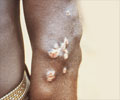The most rigorous evaluation of the impact on reducing the days of antibiotic therapy in a children's hospital using an antibiotic stewardship program has been released.

Up to 35% of inpatient antibiotic prescriptions are either unnecessary or inappropriate. The Infectious Diseases Society of America's (IDSA) 2007 guideline on the implementation of hospital ASPs described two core stewardship strategies to curb the rise of drug-resistant microbes: prospective-audit-with-feedback, and preauthorization. IDSA said that research would be needed to determine whether these strategies would be effective in pediatrics.
In this more-than-33-month study of 8,765 patients, Newland et al, observed a significant decrease in antibiotic usage—ranging from a 37% decrease in the early months, to 13% at the end of the observation. In particular, the study showed up to a 19% monthly reduction in broad-spectrum antibiotics, which the Centers for Disease Control and Prevention have recommended avoiding in order to prevent resistance in hospitalized children.
In the companion article, Stach et al, describe the five-part process they used to create their ASP, including: forming a multi-disciplinary team; determining the type of program (prospective-audit-with-feedback) and which antimicrobials to monitor; deciding which mechanism to use in identifying patients (a report was created in the hospital's EMR system); developing and implementing an evaluation process; and, communicating the goals and logistics of the ASP to the hospital's affected clinicians.
The authors surveyed 365 clinicians; the 56% who responded had a positive view of the ASP. The overwhelming majority agreed that the ASP had improved the use (83%) of antibiotics, decreased their inappropriate use (84%), and improved the quality of patient care (82%). An ASP goal was to provide education to those affected by the program; 90% said it did and 66% agreed it led to practice changes. Of negative feelings, only 6% felt the ASP interfered with clinical decision-making and 5% thought the ASP's recommendations were threatening.
Advertisement













